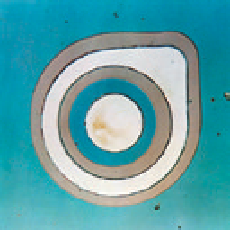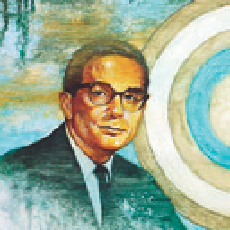Information Technology Reference
In-Depth Information
Fig. 7.9. In geology, a mesa is a flat-
topped mountain, typically found in
the U.S. Southwest as in this example
in Monument Valley. In the same way, a
semiconductor mesa transistor also rises
above the surrounding semiconductor
base with a height typically less than
one micron.
Fig. 7.10. (a) A view of Hoerni's planar
transistor under the microscope. (b) A
diagram showing the bowls of p-type
semiconductor and n-type semiconduc-
tor together with connections for the
emitter, base, and collector. The entire
surface would be coated with silicon
dioxide.
(a)
(b)
Emitter
Base
Collector
N
P
N
you had a whole bunch of transistors embedded in an insulating surface, and
the next thing was that, instead of cutting them apart physically, you cut
them apart electrically, added the other components you needed for circuits,
and finally the interconnection wiring.
6
There were several techniques, but the main one was, basically, to
build back to back diodes [p-n junctions] into the silicon between any two
transistors so that no current could flow between the two in either direction.
The other element you needed was a resistor, and it was relatively simple
to make a diode-isolated piece of silicon that acts as a resistor. You now had
resistors and transistors, and could start building logic circuits, which you
could interconnect by evaporating metal on top of the insulating layer. So it
was a progressive buildup of bits and pieces of the technology to make the
whole thing possible.
7
Noyce's patent for his version of the IC was filed in July 1959 (
Fig. 7.11
).
His assembly of the key component technologies produced a design for
a circuit that could be mass produced. Because ICs were made from tiny
chips of silicon, they became known as
chips
or
microchips
. Fairchild started
marketing a whole family of logic chips - the decision-making units of
computers - in 1962.
Also in 1962, a new type of transistor debuted that could be more easily
incorporated in mass-produced chips. This was the MOSFET, the
metal-oxide-
semiconductor field effect transistor
. It was first successfully produced by John
Atalla and Dawon Khang of Bell Labs in 1959. Bell Labs did not pursue the
B.7.6. Jean Hoerni (1927-94) was the
inventor of the planar process that
revolutionized chip production.



















Search WWH ::

Custom Search